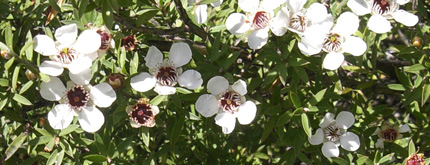
Origins of New Zealand Manuka
Leptospermum scoparium

Manuka grows extensively throughout New Zealand from sea level to about 1,000 meters above sea level.
It often forms vast scrubby areas which protect regenerating native forest. Often the bane of farmers, as it grows quickly and densely when young. The trees grow to about four meters tall with spreading ascending branches. Manuka wood makes excellent firewood when dry, and also gives a beautiful flavour when used for smoking fish or bacon.
The leaves are small, about 5mm across and 10-12mm long. Leaves grow in clusters and when crushed, give an aromatic smell. This scent led early settlers to use the leaves as tea. This gives the tree its common name “Tea Tree”.
Manuka flowers bloom in spring and appear to smother the tree. Whole hillsides can seem as though they are covered in snow, due to the prolific spread of the small white blossoms. Here in Coromandel, Mānuka often blooms twice a year.

Manuka honey is collected by beekeepers from areas such as these, and is highly prized for its antibacterial and healing properties.
Methylgloxal (MGO) is the antibacterial property identified in Manuka honey.
(Identification and quantification of methylglyoxal as the dominant antibacterial constituent of Manuka (Leptospermum scoparium) honeys from New Zealand - Elvira Mavric, Silvia Wittmann, Gerold Barth and Thomas Henle)
Traditionally, the bark, leaves, flowers and seeds were all used. Often in conjunction with other leaves or plants.
Chewing the green seeds cured diarrhoea, the inside of the bark when mixed with water was used for sore throats and as a sedative. The leaves were boiled and the liquid consumed to aid kidney and bladder function, and the vapour from the boiled leaves also helped clear headaches and blocked sinuses.
Manuka oil is commonly used for deterring headlice, drying and clearing acne, and in boiling water as a sinus clearing inhalant. Manuka is used in our Manuka Salve for its antifungal and antibacterial properties.